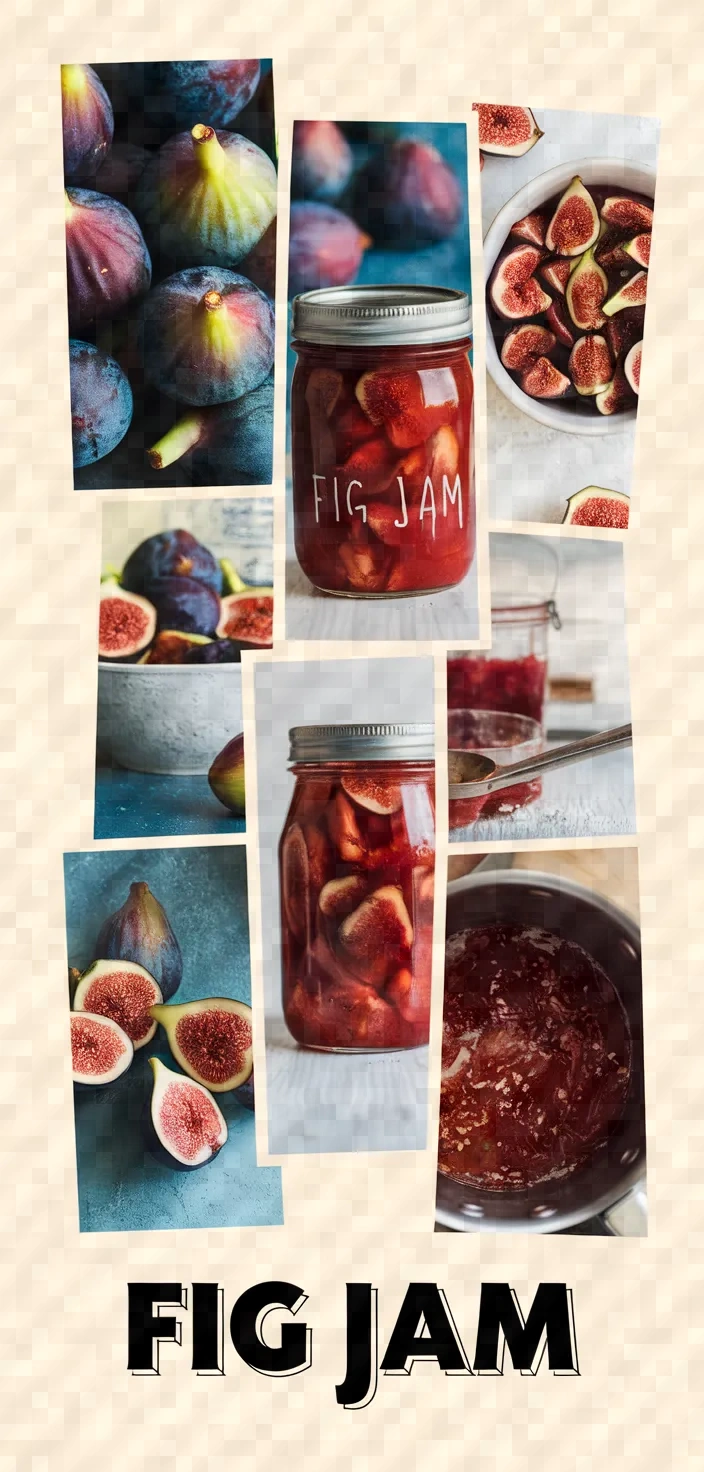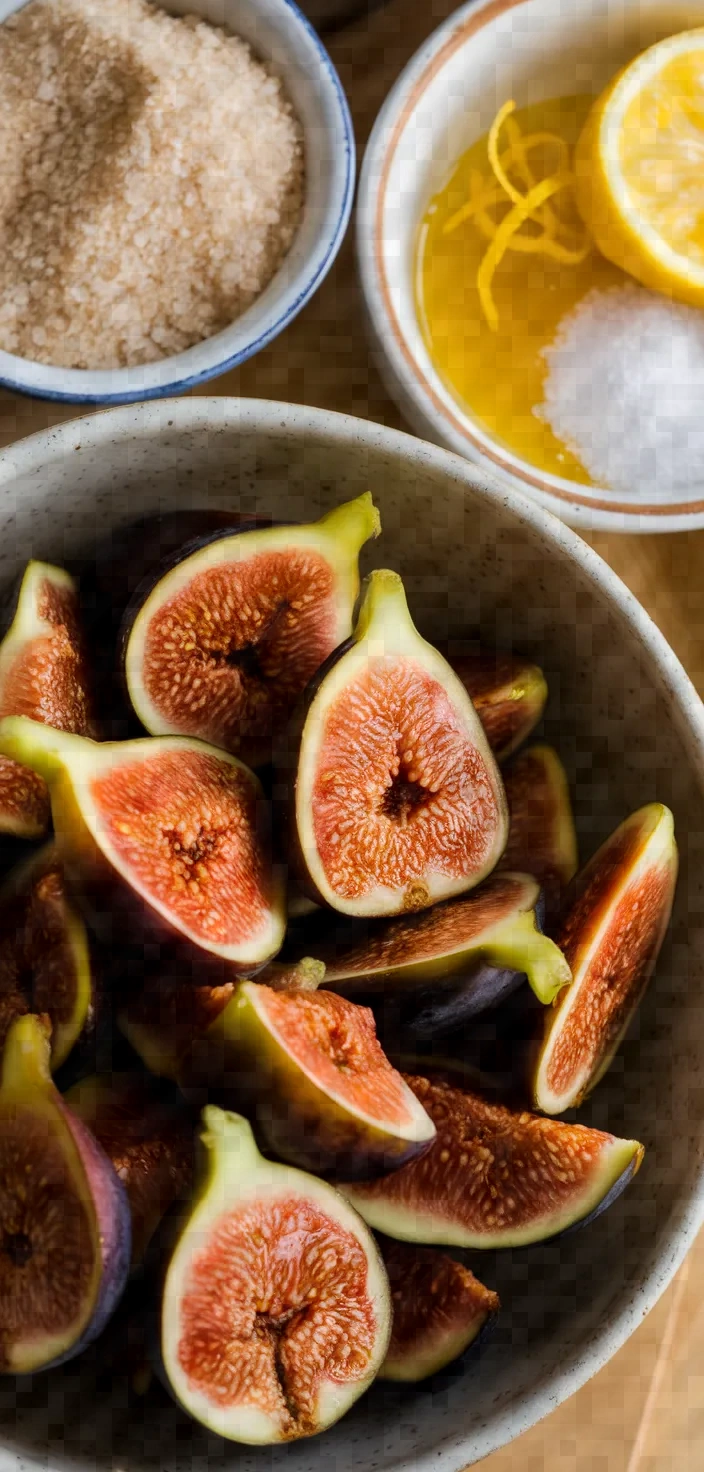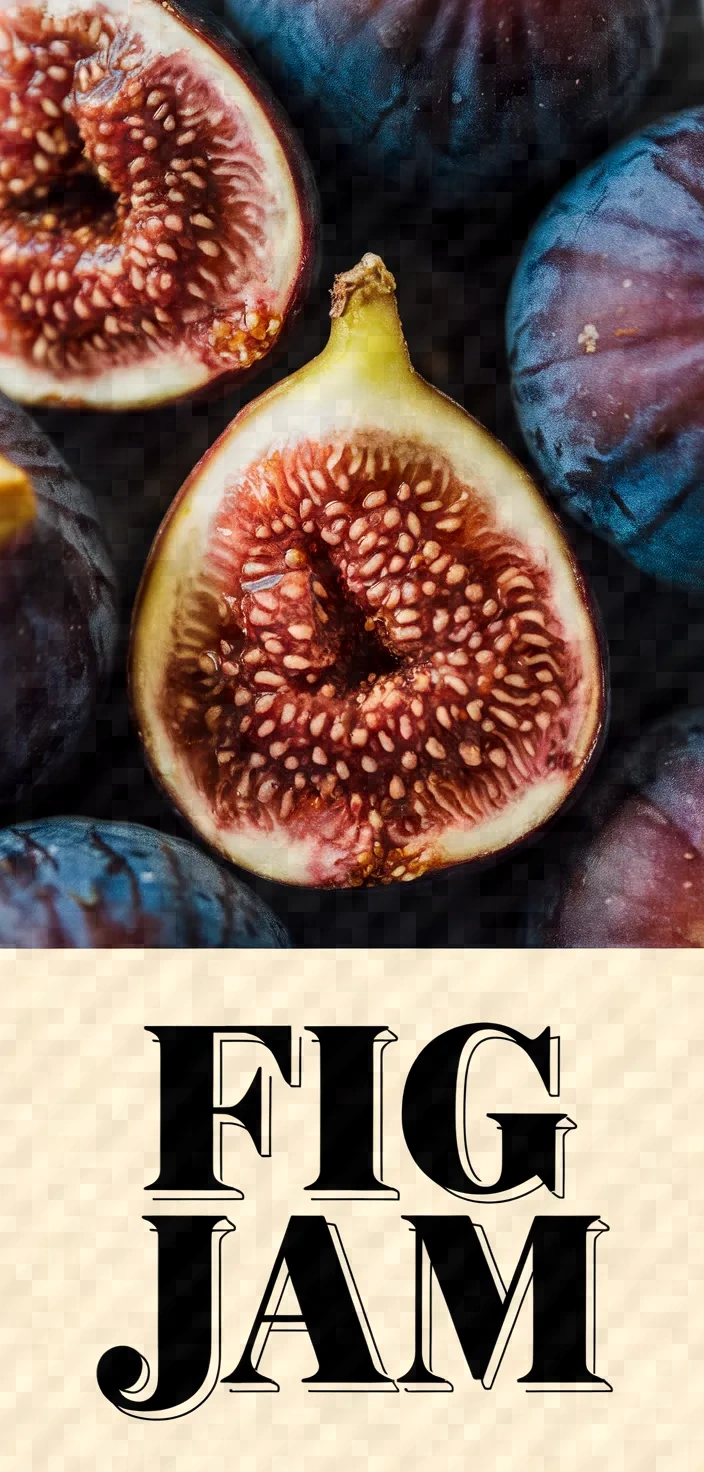Hey there, fig lovers! Picture this: a batch of homemade fig jam so luscious and inviting, it feels like capturing the very essence of sunshine in a jar. Join me on this jam-making journey where figs and lemon dance together to create the ultimate spreadable delight!

I adore developing concoctions that call for only the finest, freshest, most natural ingredients, and my fig jam is a perfect example. With the most plump and juicy of Calimyrna figs, granulated sugar, and the barest whiff of lemon, I reckon the jam has it exactly right in terms of sweetness and acidity, making for a spread that is not only perfectly balanced but also rich in fiber and antioxidants.
Fig Jam Recipe Ingredients

- Fresh Figs: Rich in dietary fiber and natural sugars, figs provide a sweet, luscious base and are also high in antioxidants and essential minerals.
- Granulated Sugar: Adds sweetness and aids in the preservation process, providing the jam with its classic, spreadable texture.
- Lemon Juice: Balances the sweetness with a tart note and contains vitamin C, which enhances flavor and helps set the jam.
- Lemon Zest: Offers a burst of bright citrus aroma that complements the figs and elevates the jam’s depth of flavor.
- Salt: Enhances and balances the sweetness, subtly intensifying the overall flavor profile of the jam.
Fig Jam Recipe Ingredient Quantities
- 2 pounds fresh figs, stemmed and quartered
- 2 cups granulated sugar
- 1/4 cup lemon juice
- 1 teaspoon lemon zest
- 1/4 teaspoon salt
How to Make this Fig Jam Recipe
1. Start by rinsing the figs well in cold running water. Use a clean kitchen towel to dry them thoroughly.
2. Take the figs and remove their stems. Cut the figs into quarters.
3. In a big saucepan, mix the figs cut into quarters, the sugar, the juice of the lemon, the zest of the lemon, and the salt.
4. Gently mix the mixture so that the figs become well acquainted with the sugar and other ingredients.
5. For about 30 minutes, have the fig mixture sit. This allows the sugar to dissolve some and the flavors to really meld.
6. Put the pot on medium heat and heat up the mix until it shows gentle boiling action, stirring now and then to keep it from sticking.
7. When it reaches a boil, turn down the heat, and let it simmer. Stir often. Use a potato masher to break down the figs.
8. Maintain a simmer on the jam for roughly 45 to 60 minutes, or until it attains a density and smoothness that will allow it to spread easily. Be quite regular in stirring so that it does not stick.
9. To check if it is done, take a little jam and place it on a cold plate. Let it cool for a moment. Now, run your finger through it. If it barely wrinkles and maintains that shape, then what you have is jam, not liquid. You have achieved canning success.
10. Once prepared, take the jam off the heat and gently ladle it into clean, sterilized jars. Leave about 1/4 inch of headspace in each jar. Immediately seal the jars and let them cool all the way to room temperature before storing.
Fig Jam Recipe Equipment Needed
1. Kitchen sink
2. Clean kitchen towel
3. Cutting board
4. Knife
5. Big saucepan
6. Stirring spoon
7. Potato masher
8. Timer or clock
9. Cold plate
10. Ladle
11. Clean, sterilized jars with lids
FAQ
- Q: Can I use dried figs instead of fresh figs?Figs in their accustomed state are best for texture and flavor. But if you’re caught without fresh figs, have no access to them, or it’s truly off-season, you might try using reconstituted dried figs in their refillable container.
- Q: How long does the fig jam last once made?Fig jam can last up to two weeks if it is kept stored in a sealed jar in the refrigerator.
- Q: Can I reduce the sugar in the recipe?A: Yes, however, cutting back on the sugar may impact the jam’s final texture and preservation properties.
- Q: Is it necessary to add lemon juice and zest?A: Brightness and balance come from the juice and zest of lemons, so to achieve optimal flavor in your dish, they are what you should reach for.
B: Juice and zest from lemons lend brightness and balance to the optimal flavor of your dish. - Q: Can this recipe be doubled?A: You certainly can double the recipe; just make sure you have a big enough pot to hold all that volume!
- Q: How do I know when the jam is ready?The jam is prepared when it thickens sufficiently to coat the back of a spoon and maintains its form when a tiny bit is set on a cold plate.
Fig Jam Recipe Substitutions and Variations
1 pound fresh figs = 1 pound dried figs, but soak them in water before using.
2 cups granulated sugar can be replaced with 2 cups honey or 2 cups light brown sugar for a different flavor profile.
1/4 cup lemon juice can be switched out with 1/4 cup lime juice or 1/4 cup orange juice for a milder acidity.
1 teaspoon lemon zest can be exchanged for 1 teaspoon lime zest or 1 teaspoon orange zest. The latter two replacements yield a distinct aroma one might not expect in a dish calling for lemon zest.
You can omit the salt or substitute it with an equal amount of sea salt for a slight variation in flavor.
Pro Tips
1. Use High-Quality Figs Start with ripe, high-quality figs for the best flavor and texture. Avoid figs that are overly soft or fermented.
2. Sterilize Jars Properly Ensure your jars and lids are sterilized before filling them with jam. You can do this by boiling them in water for 10 minutes. This step is crucial for preserving your jam safely and avoiding spoilage.
3. Add Pectin for Stability If you prefer a firmer jam, consider adding a commercial pectin according to the package instructions. This can help thicken the jam more quickly and consistently.
4. Flavor Enhancements Consider adding a cinnamon stick or a vanilla bean to the saucepan for an extra layer of flavor. Remove before ladling the jam into jars.
5. Cool-Down Test Place several small plates in the freezer when you start cooking the jam. Use these chilled plates to test the jam’s readiness. This will speed up the testing process and give you a more accurate read on the jam’s setting point.

Fig Jam Recipe
My favorite Fig Jam Recipe
Equipment Needed:
1. Kitchen sink
2. Clean kitchen towel
3. Cutting board
4. Knife
5. Big saucepan
6. Stirring spoon
7. Potato masher
8. Timer or clock
9. Cold plate
10. Ladle
11. Clean, sterilized jars with lids
Ingredients:
- 2 pounds fresh figs, stemmed and quartered
- 2 cups granulated sugar
- 1/4 cup lemon juice
- 1 teaspoon lemon zest
- 1/4 teaspoon salt
Instructions:
1. Start by rinsing the figs well in cold running water. Use a clean kitchen towel to dry them thoroughly.
2. Take the figs and remove their stems. Cut the figs into quarters.
3. In a big saucepan, mix the figs cut into quarters, the sugar, the juice of the lemon, the zest of the lemon, and the salt.
4. Gently mix the mixture so that the figs become well acquainted with the sugar and other ingredients.
5. For about 30 minutes, have the fig mixture sit. This allows the sugar to dissolve some and the flavors to really meld.
6. Put the pot on medium heat and heat up the mix until it shows gentle boiling action, stirring now and then to keep it from sticking.
7. When it reaches a boil, turn down the heat, and let it simmer. Stir often. Use a potato masher to break down the figs.
8. Maintain a simmer on the jam for roughly 45 to 60 minutes, or until it attains a density and smoothness that will allow it to spread easily. Be quite regular in stirring so that it does not stick.
9. To check if it is done, take a little jam and place it on a cold plate. Let it cool for a moment. Now, run your finger through it. If it barely wrinkles and maintains that shape, then what you have is jam, not liquid. You have achieved canning success.
10. Once prepared, take the jam off the heat and gently ladle it into clean, sterilized jars. Leave about 1/4 inch of headspace in each jar. Immediately seal the jars and let them cool all the way to room temperature before storing.
